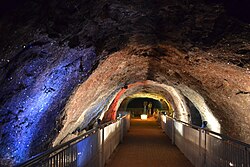
Back Xevra duz mədəni Azerbaijani Salzbergwerk Khewra German معدن نمک خیرا Persian Mine de sel de Khewra French खेवड़ा नमक खान Hindi Tambang garam Khewra ID Miniera di sale di Khewra Italian ഖേവ്ര ഉപ്പുഖനി Malayalam ਖੇਵੜਾ ਲੂਣ ਦੀ ਖਾਣ Punjabi کھیوڑا نمک کان PNB
 Khewra Salt Mine tunnel (Crystal Valley) | |
| Location | |
|---|---|
| Location | Khewra |
| Province | |
| Country | |
| Coordinates | 32°38′52.58″N 73°00′30.22″E / 32.6479389°N 73.0083944°E |
| Production | |
| Products | Rock salt |
| Production | 3,50,000 MT |
| Financial year | 2019–20 |
| History | |
| Opened | 1872 |
| Active | 150 years |
| Owner | |
| Company | Pakistan Mineral Development Corporation |
| Website | www.PMDC.gov.pk |
The Khewra Salt Mine (Punjabi, Urdu: کھیوڑہ نمک کان), also known as Mayo Salt Mine, is the world's second largest salt mine, located in Khewra, Punjab, Pakistan.[1] The mine is in the Salt Range of the Potohar plateau, which rises from the Indus plain of the Punjab.[2] [3][4][5][6]
The mine is famous for its production of pink Khewra salt, often marketed as Himalayan salt, and is a major tourist attraction, drawing up to 250,000 visitors a year.[7] Its history dates back to its discovery by Alexander's troops in 326 BC, but it started trading in the Mughal era.[8] The main tunnel at ground level was developed by H. Warth, a mining engineer, in 1872 during British rule. After independence, the BMR took possession until 1956 and then PIDC owned the mines till 1965. After India-Pakistan war in 1965, the WPIDC took over the administration of salt mines and in 1974, the Pakistan Mineral Development Corporation took over the mine, which still remains the largest source of salt in the country, producing more than 350,000 tons per annum[9] of about 99% pure halite.[7] Estimates of the reserves of salt in the mine vary from 82 million tons[10] to 600 million tons.[11]
- ^ O.H.K. Spate; Andrew T.A. Learmonth; B.H. Farmer (13 July 1972). India, Pakistan and Ceylon: The Regions. Methuen Publishing Ltd. p. 502. ISBN 978-0-416-75530-5. Retrieved 3 April 2012.
- ^ Weller, J. Marvyn (1928). "The Cenozoic History of the Northwest Punjab". The Journal of Geology. 36 (4). Chicago Journals: 362–375. doi:10.1086/623522. JSTOR 30055696. S2CID 129105623.
- ^ Stanley J. Lefond (1 January 1969). Handbook of World Salt Resources (1st ed.). Springer. p. 347. ISBN 978-0-306-30315-9. Retrieved 3 April 2012.
- ^ Camerapix (July 1998). Spectrum Guide to Pakistan. Interlink Books. p. 150. ISBN 978-1-56656-240-9. Retrieved 8 April 2012.
- ^ Masud ul Hasan (1975). Short encyclopaedia of Pakistan (1st ed.). Ferozsons. p. 118. ASIN B007EU8QHS. Retrieved 8 April 2012.
- ^ Cite error: The named reference
Pete Heidenwas invoked but never defined (see the help page). - ^ a b Cite error: The named reference
Privatization Commission: PMDCwas invoked but never defined (see the help page). - ^ Sarina Singh; Lindsay Brown; Lindsay Brown; Rodney Cocks; John Mock (1 May 2008). Lonely Planet Pakistan and the Karakoram Highway (7th ed.). Lonely Planet. p. 138. ISBN 978-1-74104-542-0. Retrieved 3 April 2012.
- ^ Pennington, Matthew (25 January 2005). "Pakistan salt mined old-fashioned way mine". The Seattle Times. Archived from the original on 25 July 2012. Retrieved 8 April 2012.
- ^ Cite error: The named reference
natreswas invoked but never defined (see the help page). - ^ Cite error: The named reference
U.S. Geological Surveywas invoked but never defined (see the help page).
© MMXXIII Rich X Search. We shall prevail. All rights reserved. Rich X Search

